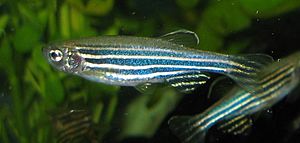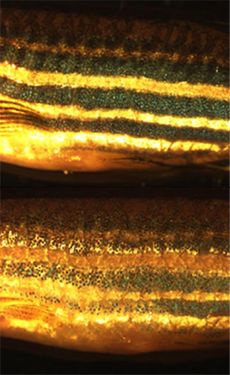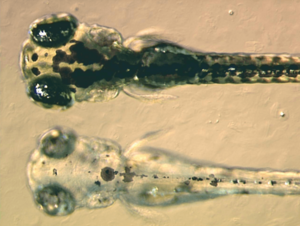Zebrafish facts for kids
Quick facts for kids Danio rerio |
|
|---|---|
 |
|
| An adult female zebrafish | |
| Conservation status | |
| Scientific classification | |
| Synonyms | |
|
The zebrafish (Danio rerio) is a freshwater fish belonging to the minnow family (Cyprinidae) of the order Cypriniformes. Native to India and South Asia, it is a popular aquarium fish, frequently sold under the trade name zebra danio (and thus often called a "tropical fish" although both tropical and subtropical). It is also found in private ponds.
The zebrafish is an important and widely used vertebrate model organism in scientific research, for example in drug development, in particular pre-clinical development. It is also notable for its regenerative abilities, and has been modified by researchers to produce many transgenic strains.
Taxonomy
The zebrafish is a derived member of the genus Brachydanio, of the family Cyprinidae. It has a sister-group relationship with Danio aesculapii. Zebrafish are also closely related to the genus Devario, as demonstrated by a phylogenetic tree of close species.
Distribution
Range
The zebrafish is native to freshwater habitats in South Asia where it is found in India, Pakistan, Bangladesh, Nepal and Bhutan. The northern limit is in the South Himalayas, ranging from the Sutlej river basin in the Pakistan–India border region to the state of Arunachal Pradesh in northeast Indian. Its range is concentrated in the Ganges and Brahmaputra River basins, and the species was first described from Kosi River (lower Ganges basin) of India. Its range further south is more local, with scattered records from the Western and Eastern Ghats regions. It has frequently been said to occur in Myanmar (Burma), but this is entirely based on pre-1930 records and likely refers to close relatives only described later, notably Danio kyathit. Likewise, old records from Sri Lanka are highly questionable and remain unconfirmed.
Zebrafish have been introduced to California, Connecticut, Florida and New Mexico in the United States, presumably by deliberate release by aquarists or by escape from fish farms. The New Mexico population had been extirpated by 2003 and it is unclear if the others survive, as the last published records were decades ago. Elsewhere the species has been introduced to Colombia and Malaysia.
Habitats
Zebrafish typically inhabit moderately flowing to stagnant clear water of quite shallow depth in streams, canals, ditches, oxbow lakes, ponds and rice paddies. There is usually some vegetation, either submerged or overhanging from the banks, and the bottom is sandy, muddy or silty, often mixed with pebbles or gravel. In surveys of zebrafish locations throughout much of its Bangladeshi and Indian distribution, the water had a near-neutral to somewhat basic pH and mostly ranged from 16.5 to 34 °C (61.7–93.2 °F) in temperature. One unusually cold site was only 12.3 °C (54.1 °F) and another unusually warm site was 38.6 °C (101.5 °F), but the zebrafish still appeared healthy. The unusually cold temperature was at one of the highest known zebrafish locations at 1,576 m (5,171 ft) above sea level, although the species has been recorded to 1,795 m (5,889 ft).
Description
The zebrafish is named for the five uniform, pigmented, horizontal, blue stripes on the side of the body, which are reminiscent of a zebra's stripes, and which extend to the end of the caudal fin. Its shape is fusiform and laterally compressed, with its mouth directed upwards. The male is torpedo-shaped, with gold stripes between the blue stripes; the female has a larger, whitish belly and silver stripes instead of gold. The zebrafish can reach up to 4–5 cm (1.6–2.0 in) in length, although they typically are 1.8–3.7 cm (0.7–1.5 in) in the wild with some variations depending on location. Its lifespan in captivity is around two to three years, although in ideal conditions, this may be extended to over five years. In the wild it is typically an annual species.
Psychology
In 2015, a study was published about zebrafishes' capacity for episodic memory. The individuals showed a capacity to remember context with respect to objects, locations and occasions (what, when, where). Episodic memory is a capacity of explicit memory systems, typically associated with conscious experience.
The Mauthner cells integrate a wide array of sensory stimuli to produce the escape reflex. Those stimuli are found to include the lateral line signals by McHenry et al. 2009 and visual signals consistent with looming objects by Temizer et al. 2015, Dunn et al. 2016, and Yao et al. 2016.
Reproduction
The approximate generation time for Danio rerio is three months. Zebrafish are asynchronous spawners and under optimal conditions (such as food availability and favorable water parameters) can spawn successfully frequently, even on a daily basis. Females are able to spawn at intervals of two to three days, laying hundreds of eggs in each clutch. Upon release, embryonic development begins. Fertilized eggs almost immediately become transparent, a characteristic that makes D. rerio a convenient research model species. Sex determination of common laboratory strains was shown to be a complex genetic trait, rather than to follow a simple ZW or XY system.
The zebrafish embryo develops rapidly, with precursors to all major organs appearing within 36 hours of fertilization. The embryo begins as a yolk with a single enormous cell on top (see image, 0 h panel), which divides into two (0.75 h panel) and continues dividing until there are thousands of small cells (3.25 h panel). The cells then migrate down the sides of the yolk (8 h panel) and begin forming a head and tail (16 h panel). The tail then grows and separates from the body (24 h panel). The yolk shrinks over time because the fish uses it for food as it matures during the first few days (72 h panel). After a few months, the adult fish reaches reproductive maturity (bottom panel).
To encourage the fish to spawn, some researchers use a fish tank with a sliding bottom insert, which reduces the depth of the pool to simulate the shore of a river. Zebrafish spawn best in the morning due to their Circadian rhythms. Researchers have been able to collect 10,000 embryos in 10 minutes using this method. In particular, one pair of adult fish is capable of laying 200–300 eggs in one morning in approximately 5 to 10 at time. Male zebrafish are furthermore known to respond to more pronounced markings on females, i.e., "good stripes", but in a group, males will mate with whichever females they can find. What attracts females is not currently understood. The presence of plants, even plastic plants, also apparently encourages spawning.
Exposure to environmentally relevant concentrations of diisononyl phthalate (DINP), commonly used in a large variety of plastic items, disrupt the endocannabinoid system and thereby affect reproduction in a sex-specific manner.
Feeding
Zebrafish are omnivorous, primarily eating zooplankton, phytoplankton, insects and insect larvae, although they can eat a variety of other foods, such as worms and small crustaceans, if their preferred food sources are not readily available.
In research, adult zebrafish are often fed with brine shrimp, or paramecia.
In the aquarium
Zebrafish are hardy fish and considered good for beginner aquarists. Their enduring popularity can be attributed to their playful disposition, as well as their rapid breeding, aesthetics, cheap price and broad availability. They also do well in schools or shoals of six or more, and interact well with other fish species in the aquarium. However, they are susceptible to Oodinium or velvet disease, microsporidia (Pseudoloma neurophilia), and Mycobacterium species. Given the opportunity, adults eat hatchlings, which may be protected by separating the two groups with a net, breeding box or separate tank. In captivity, zebrafish live approximately forty-two months. Some captive zebrafish can develop a curved spine.
The zebra danio was also used to make genetically modified fish and were the first species to be sold as GloFish (fluorescent colored fish).
Strains
In late 2003, transgenic zebrafish that express green, red, and yellow fluorescent proteins became commercially available in the United States. The fluorescent strains are tradenamed GloFish; other cultivated varieties include "golden", "sandy", "longfin" and "leopard".
The leopard danio, previously known as Danio frankei, is a spotted colour morph of the zebrafish which arose due to a pigment mutation. Xanthistic forms of both the zebra and leopard pattern, along with long-finned strains, have been obtained via selective breeding programs for the aquarium trade.
Various transgenic and mutant strains of zebrafish were stored at the China Zebrafish Resource Center (CZRC), a non-profit organization, which was jointly supported by the Ministry of Science and Technology of China and the Chinese Academy of Sciences.
Scientific research


D. rerio is a common and useful scientific model organism for studies of vertebrate development and gene function. Its use as a laboratory animal was pioneered by the American molecular biologist George Streisinger and his colleagues at the University of Oregon in the 1970s and 1980s; Streisinger's zebrafish clones were among the earliest successful vertebrate clones created. Its importance has been consolidated by successful large-scale forward genetic screens (commonly referred to as the Tübingen/Boston screens). The fish has a dedicated online database of genetic, genomic, and developmental information, the Zebrafish Information Network (ZFIN). The Zebrafish International Resource Center (ZIRC) is a genetic resource repository with 29,250 alleles available for distribution to the research community. D. rerio is also one of the few fish species to have been sent into space.
Research with D. rerio has yielded advances in the fields of developmental biology, oncology, toxicology, reproductive studies, teratology, genetics, neurobiology, environmental sciences, stem cell research, regenerative medicine, muscular dystrophies and evolutionary theory.
See also
 In Spanish: Danio rerio para niños
In Spanish: Danio rerio para niños
- Japanese rice fish or medaka, another fish used for genetic, developmental, and biomedical research
- List of freshwater aquarium fish species
- Denison barb



